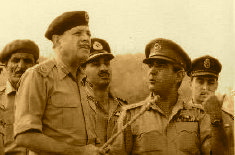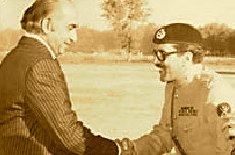Through my researches about the history of Pakistan, I have come upon a rather curious pattern. It is the recurrence of “peak moments” precisely every twentieth year (with one interesting change).
The gathering of Muslim community representatives from all over India at Aligarh in 1886 was the first of its kind in Islam since the days of the early caliphs. Strangely, something similar has been happening since then – every twentieth year with a slight change in 1947:
1886, Foundation of Muslim Educational Conference
1906, Foundation of All-India Muslim League
1926, General Elections on the basis of separate electorates
1946, General Elections on the question of Pakistan
1967, Birth of PPP and popularity of 6 Points
1987, General discontent with General Zia
2007, Lawyers’ Movement
Why does it happen, and can it help us in a better understanding of our history (and of ourselves)?
That question can be answered in several ways depending on how you approach it. Yet, in whatever way these “peak moments†are interpreted, they help us divide the history of Pakistan since 1886 into seven symmetrical periods:
1886-1905, Inquiry
1906-1925, Discovery
1926-1946, Transcendence
1947-1966, Freedom
1967-1986, Action
1987-2006, Expansion
2007-26, Creation
The names of the stages (i.e. inquiry, discovery, and so on) have been taken from the “Seven Stages” which recur in Iqbal’s work as I’ve shown in my book The Republic of Rumi: A Novel of Reality (2007) and discussed briefly in my online newsletter. Needless to say, those who may like to name these periods differently can do so (“What’s there in a name…”)!
The beauty of dividing history into these seven periods is that not only this division is symmetrical but it is based on the peak moments of the entire society rather than the coming and going of individual rulers. Does this sound better than naming the periods of our history “the Ayub Khan era”, “the Yahya Khan era,” and so on? To me, it does.
There are other uses. Patterns naturally lead to the possibility of forecasting. Once we observe certain patterns in the history of Pakistan we are likely to recognize the possibility of forecasting the future of this nation. In order to test my observations since I first came upon them in the summer of 2007, I have been making forecasts: about the results of Elections 2008, for instance. Such forecasts have turned out to be correct.
Yet, quite understandably, I have faced so much hostility from some “friends and foes†on this issue that I think I should now withhold my interpretations until I get the opportunity of displaying the background reading involved in the matter (for now, it may suffice to say that Muhammad Ali Jauhar, who had a degree in history from Oxford, was also working along these lines but unfortunately there had been only two peak moments by then, and hence not enough data to proceed with the investigations).
The beauty of this twenty-year division is such that I don’t want to spoil it even for a skeptic: in my zeal for saying more, I don’t want to put off any who might be more sympathetic to it if I left it at this but whose minds may get shut off if I said more!





















































There is a common theme in the downfall of all muslim insitutions.i.e., Mullah. Pakistan, a potential Grenada in making has been reduced to rubble at its foundations. The article above mentions a number of milestones after the creation of Pakistan which are but minor blips in the uniform anarchy produced by religious zealots. The birth of PPP could have been a substantial step towards the development of a progressive state, but alas, Mullah not only manipulated ZAB but also caused his downfall and judicial murder. Even the educational reforms were shunned by the orthodoxy. Muslim league was opposed by this clergy and the idea of Pakistan was reviled by it. Pick any point in the history of Pakistan, look at any era, any year and you will see the hideous shadow of the extremist zealots in the background. Nowadays, they are in the foreground.
Inquiry: The muslim identity. Orthodoxy had always defined the muslim identity as a superior population among the native hindus. This very idea caused the muslims to stay behind in persuit of education.
Discovery, Transcendence, Freedom: You will find that unlike the educated “muslim league”, the orthodoxy did not discover the state of afairs in India. They followed Gandhi and Nehru as Indians. They discovered that India was “Darul Harb”. This continued until the partition. After Partition, Mullah had no place in the new country.. 1953 provided a reason to be importan. Anti-Ahmadi riots provided the reason for Jamaat Islami, Jamiat Ulema, Ahrar to gather support. They also gathered momentum from this. 1965 war provided a little buffer, but they continued through the decade. JI helped the persecution of liberal bangalis and made the situation worse in East Pakistan.
Action: What action. The only actions I see are.. The first comprehensive constition which was mutilated straight away. The Ahmadi amendment. Then the action was “Nizam e Mustafa” action. Causing the downfall of a democratically elected government, a judicial murder, and the strengthening of a dictator who reminds us of the times of pharoahs. The action of “majlise shoora”, more mutilations of the constitution. public floggings, executions, and Jihad which has turned against the very people who supported it.
Expansion: Inflation rather. Inflation of egos, of the PPP which was only an empty shell of its ideals.. Fragmentation of the right wing into many different mullah influenced factions. Some (recent) center right wingers are more left wing than the PPP. All depends on who is flapping their wings. This expansion stage is more like scattering/shattering of the national identity.
Creation: I hope out of these ashes a wisened nation emerges. But Mullah is still around adding more fuel to the fire. We have to wait until he is done.
Lutful Islam, Could you please further shed light on part two of your three stages. This Mullah deal seems interesting. Please indulge us.
what our feelings,what we thought,what we have done,who is responsible,what is the cure,what will happen now.Almighty Allah knows better.But we all should pray and wish for our beloved pakistan not only our country but it is demanded and Almighty Allah given us TOHFA in liew, of our unprecedental sacrifices,the Almighty Creater will take care of Pakistan and We pakistanies ,.INSHA ALLAH PAKISTAN LIVE TILL DAY OF JUDGEMENT AND WE WILL MAKE IT AS FOR WHICH WE HAVW DEMANDED.ISLAM ZINDABAD,PAKISTAN KA MATLAB KIA “LA ILAHA ILLALLAH………..”
There are three stages of Pakistan.
1: 1947; creation of Pakistan
2a: 1954: First Mullah insurgency
2b: 1974-1978 :Democarcy hijacked by Mullah
2c: Mullah supported Dictatorship.
3: The
Very interesting. I like the data points you fit to make your case. Although I think it is really driven by the desire to get neat 20 year periods.